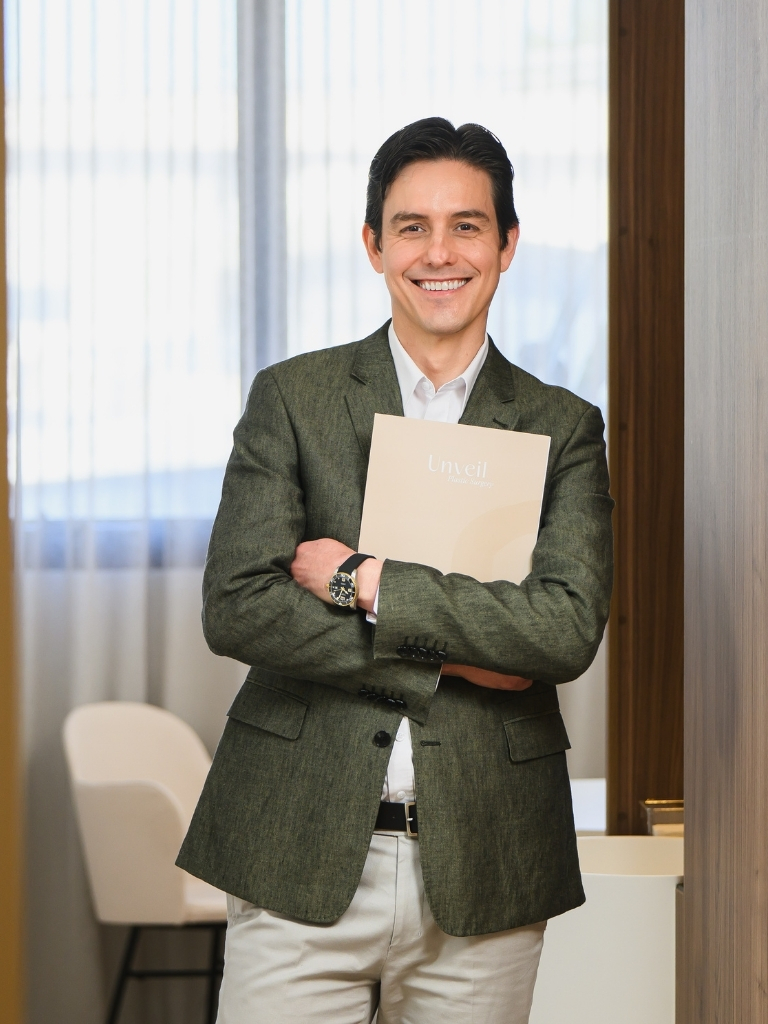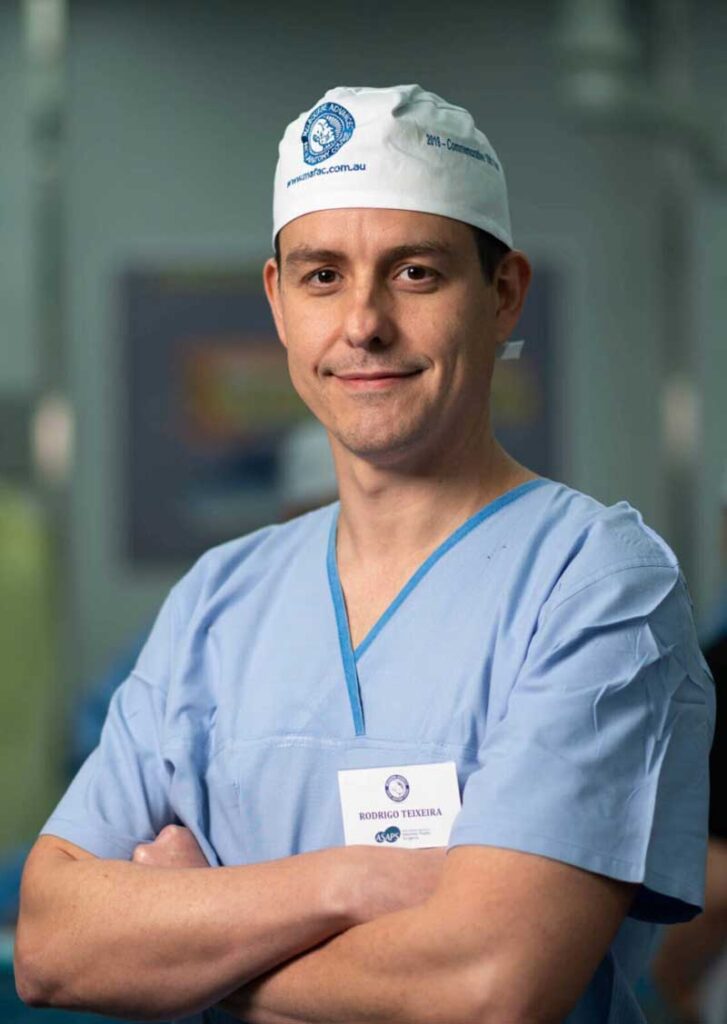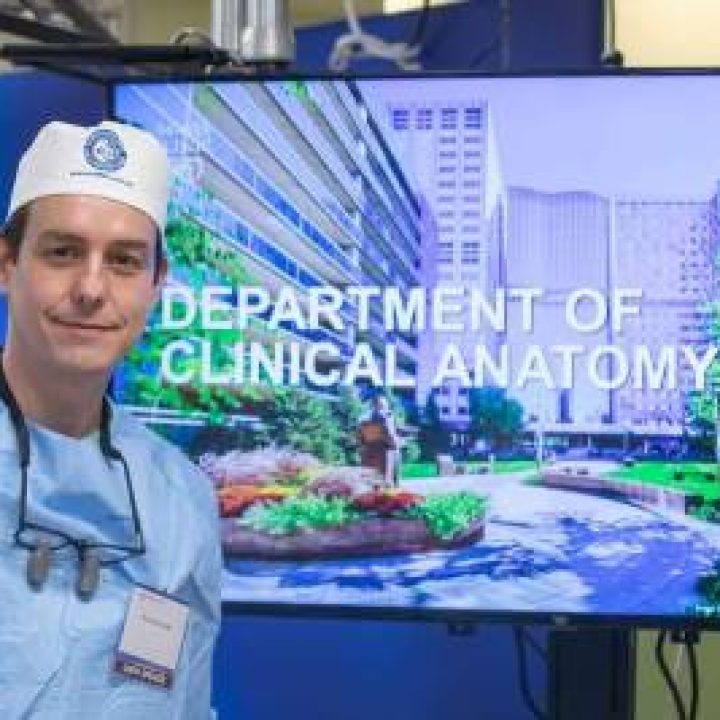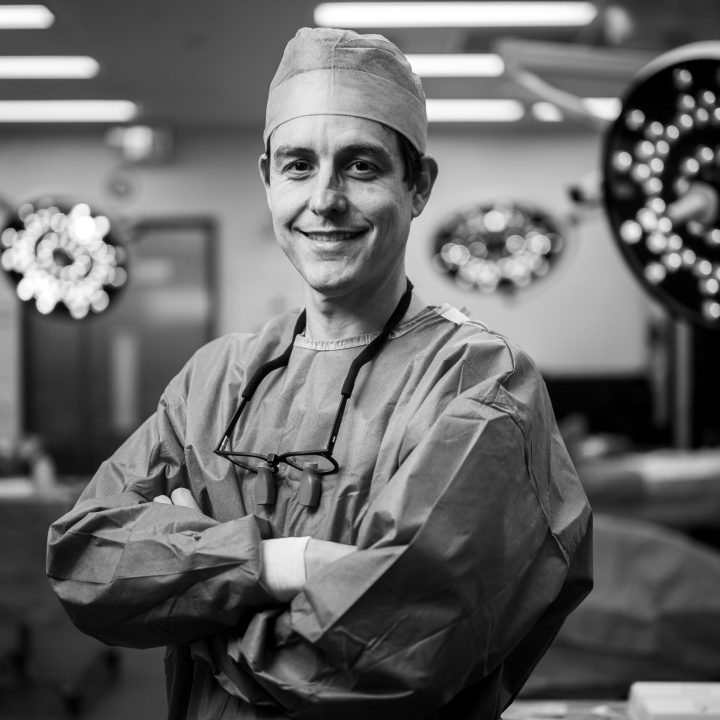Facelift Surgery in Melbourne
Dr Rodrigo Teixeira (FRACS) is a Specialist Plastic Surgeon based in Melbourne with a focus on facial plastic surgery. A facelift repositions facial tissues to restore support, contour, and definition that change with ageing and gravity. Dr Teixeira’s approach focuses on achieving balanced and proportional aesthetic refinements, tailoring each surgical plan to the patient’s anatomy and goals.
Why a Facelift May Be Considered
Facelift surgery, also called meloplasty or rhytidectomy, repositions facial tissues affected by ageing, gravity, and volume loss. It improves definition along the jawline, cheeks, and neck while preserving each individual’s own features. Incisions are typically placed around the ear and within the hairline, sometimes using endoscopic techniques to reduce visible scarring.
Current methods such as the deep plane facelift target the supportive layers beneath the skin, including the SMAS (Superficial Musculo-Aponeurotic System) and retaining ligaments, rather than tightening skin alone. This deeper approach supports longer-term contour improvement while maintaining natural expressions.
In addition to clinical work, Dr Teixeira teaches facelift anatomy and surgical approaches as part of the Mendelson Advanced Facial Anatomy Course (MAFAC), an international program for training plastic surgeons.

Learn more about Dr Rodrigo Teixeira and his approach to plastic surgery and patient care.
Facelift Techniques
Facelift surgery is tailored to the stage of ageing and individual anatomy. Dr Teixeira provides a range of techniques, selecting each approach according to structural changes, skin quality, and treatment goals, with careful attention to balance, function, and safety.
Short-Scar (Mini) Facelift
A short-scar (mini) facelift may be suitable for patients in the early stages of facial ageing who have good skin elasticity and minimal neck laxity. This technique focuses on improving definition in the lower face and jawline through small incisions placed discreetly around the ear and within the hairline.
The underlying SMAS (Superficial Musculo-Aponeurotic System) is tightened to refine the mandibular border, reduce mild jowls, and enhance the transition between the cheek and jawline. As the dissection is less extensive than a full facelift, recovery is usually shorter and swelling more limited. The short-scar approach provides subtle yet noticeable refinement and may be complemented by fat transfer or skin treatments for more comprehensive rejuvenation.
SMAS and Advanced (High) SMAS
The SMAS (Superficial Musculo-Aponeurotic System) is a structural layer beneath the skin that helps support the facial soft tissues. As part of the ageing process, this layer may loosen, contributing to changes in the cheeks, jawline, and neck. A SMAS facelift involves repositioning this deeper layer to improve facial definition, while aiming to reduce tension on the skin.
An extended or high-SMAS approach may lift the tissue higher along the cheekbone, allowing adjustment of the midface. This technique is generally used to support a more natural contour and may contribute to longer-lasting results. In some cases, volume restoration using fat grafting is also discussed. Surgical plans are individualised and depend on each patient’s anatomy, goals, and medical suitability.
Deep Plane Facelift
The deep plane facelift is the primary technique performed by Dr Teixeira in Melbourne. By working on deeper tissue plane, beneath the SMAS, the procedure releases key ligaments and repositions the SMAS, fat pads, and skin together. This lifts the cheeks, jowls, and nasolabial folds in harmony, contouring the midface, jawline, and neck without placing excess tension on the skin.
Tissue support at a deeper level is the key aspect of this technique, which helps preserve natural facial expression, avoid overdone tightening, and keep scars less noticeable. It is especially effective for patients with midface descent, lower face laxity, or heaviness. Because the technique is performed close to facial nerve branches, it requires careful handling of tissues, understanding of the clinical anatomy, and experience.
The method was pioneered through anatomical research by Dr Bryan Mendelson and is taught internationally through the Mendelson Advanced Facial Anatomy Course (MAFAC), where Dr Teixeira is a faculty member.
Endoscopic Facelift
Endoscopic facelifts use small incisions hidden in the hairline and a camera (endoscope) to access deeper facial layers. Under magnified view, the retaining ligaments are released and deeper tissues mobilised, allowing a controlled lift. This method is generally suited to early signs of facial ageing, such as mild midface descent, early jowling, or cheek and temple volume changes.
A variation known as the Endoscopic Midface or “Ponytail Lift” elevates the midface and temple through discreet hairline incisions. Using vertical vectors and limited incisions, it can refine cheek and temple contour with less visible scarring and a shorter recovery period.
Concerns Addressed by Facelift Surgery
A facelift, particularly a deep plane facelift, can address several age-related changes in the lower face and neck:
- Softening deep nasolabial folds (nose-to-mouth lines)
- Refining the jawline and reducing jowls
- Restoring midface volume and definition
- Tightening loosened skin beneath the chin or neck
- Improving the transition between face and neck contours
By lifting and supporting the deeper layers, a facelift restores facial contour and balance while preserving natural facial expression.
Dr Teixeira's Approach to Facelift Surgery
Dr Rodrigo Teixeira approaches facelift surgery with an emphasis on restoring facial structure and proportion in a way that respects each person’s unique features. Not all faces age the same way and differences in skin quality, ligament strength, fat distribution, and bone structure mean that treatment must be individually tailored. Each facelift plan considers these variations, selecting the most appropriate options to achieve a refreshed appearance.
Facial ageing does not occur in a straight line. While “vertical restore lift” has become a common marketing phrase, facial descent follows a more complex, pendular path, shaped by the ligaments and muscles that anchor and support the face. The brow, nasolabial fold, jowl, and neck tissues descend in curved vectors rather than straight lines. Dr Teixeira’s method aims to restore the anatomy by lifting tissues along their natural arc of descent, re-establishing structural support and softening contours while preserving natural expression.
Learn more about the Deep Plane Facelift in Melbourne.
What to Expect at the Facelift Consultation
During a facelift consultation in Melbourne, Dr Rodrigo Teixeira will assess your suitability for surgery by reviewing your medical history, discussing your personal goals, and performing a photographic and anatomical assessment. A detailed facial examination evaluates skin quality, tissue laxity, facial volume, bone structure, ageing pattern, and overall facial balance. The consultation includes discussion of treatment options, recovery expectations, potential risks, and limitations to support informed consent.
In accordance with the Medical Board of Australia and AHPRA guidelines, two consultations are required before proceeding with cosmetic surgery. Motivations for surgery are explored, and screening for psychological conditions, including Body Dysmorphic Disorder (BDD), is performed when appropriate. A GP referral is required, and a seven-day cooling-off period applies after the second consultation before scheduling surgery. For further details on preparing for your consultation, visit our patient information page.
On the Day of Facelift Surgery
On the day of your facelift in Melbourne, you will be admitted to an accredited hospital. The procedure is performed under general anaesthesia. Before surgery, Dr Teixeira will review the plan and mark incision lines. You will also meet the anaesthetist, who will review your medical history, discuss anaesthesia, and explain postoperative pain management.
A checklist is completed to confirm your identity, medical history, and consent. Surgery length varies with the technique and any additional procedures. After surgery, you will be transferred to recovery and usually stay in hospital for one or two nights, depending on the extent of surgery and early recovery.

Risks and Considerations
As with any surgical procedure, facelift (meloplasty or rhytidectomy) surgery carries potential risks and limitations. These vary depending on your individual anatomy, medical history, skin condition, and the type of facelift performed.
Healing and results also differ from person to person and cannot be predicted. Common side effects following facelift surgery include:
- Bruising and swelling, usually improving within the first few weeks
- Tightness, stiffness, or mild discomfort, particularly around the cheeks and neck
- Temporary numbness or tingling near incision sites due to nerve sensitivity
- Mild asymmetry or uneven swelling during the healing process
- Temporary hair thinning near the temples or incision lines
Less common risks may include bleeding (haematoma), infection, or delayed wound healing, particularly in smokers or patients with certain medical conditions. Rare complications such as skin loss (necrosis), visible or thickened scarring, or temporary or permanent nerve injury can occur. Other possible issues include contour irregularities, earlobe changes, prolonged swelling or numbness, or the need for revision surgery if the result is unsatisfactory or healing is unpredictable.
Facelift Recovery & Aftercare
Recovery varies between individuals and depends on the type of facelift, your health, and how your body heals. Swelling and bruising are common in the first week and usually improve over two to three weeks. Some patients notice temporary tightness, numbness, or mild changes in sensation, which generally resolve with time. Understanding the typical recovery stages can help you prepare, though timelines differ for each person.
General facelift recovery recommendations include:
- Sleep on your back with your head elevated for 7 days
- Use cool packs for the first 72 hours, protecting the skin
- Take pain medicines as prescribed; avoid alcohol and mixing sedatives
- Gentle walking from day one; gradual return to exercises, avoiding strenuous exercise for 2 weeks
- Protect the face from sun damage by wearing sunscreen daily and a wide‑brim hat outdoors
- Eat nutritious food and high in fibre to support digestion; stay hydrated
- Limit strong facial movements and neck turning in the early phase
Follow‑up appointments are scheduled to monitor progress, and written aftercare instructions are provided before surgery. Dr Teixeira visits patients during their hospital stay and remains available after discharge. Contact details are provided for ongoing and urgent support.
As with any surgical procedure, outcomes vary between individuals. Recovery times and results should be discussed with a qualified specialist before proceeding.
Our Melbourne Clinic
Unveil Plastic Surgery is situated in Ivanhoe East, approximately 10 km from Melbourne’s central business district. Our clinic, located on Lower Heidelberg Road, has been designed with patient comfort, privacy, and a calm atmosphere in mind. Our consultation spaces are equipped with modern facilities to support detailed examinations, planning, and discussion.
When you arrive, our reception team will welcome you and guide you through each stage of your visit. Whether you’re seeing us for an endoscopic facelift consultation, a follow-up, or treatment, we aim to make your experience attentive and personalised. We offer easy parking nearby and strive to make the clinic accessible to all patients. We acknowledge that choosing surgery or any cosmetic procedure can involve complex emotions and decisions. Our clinic team is here to offer clear information, support, and guidance at every step.
Combining a Facelift with Other Procedures
A facelift addresses deeper tissue descent and skin laxity but may be complemented by other procedures to refine additional facial features. Facelift surgery may be combined with:
- Neck lift to refine contour beneath the chin and along the neck
- Blepharoplasty (eyelid surgery) for upper or lower eyelid concerns
- Brow lift to support the upper third of the face
- Facial Fat Transfer to restore lost volume in the midface, temples, or periorbital region
- Laser resurfacing, peels or other non-surgical treatments to support skin quality and texture
Whether a combined approach is appropriate depends on your anatomy, goals, and overall treatment plan. Each combination is carefully guided by a thorough consultation with Dr Teixeira in Melbourne, considering individual preferences, clinical suitability, and safety parameters.
Facelift Surgery FAQs
A deep plane facelift targets the deeper facial layers beneath the SMAS to release and reposition tissue more completely. This allows for natural movement, greater lift in the midface, and improved long-term support compared to techniques that tighten only the skin or superficial layers.
An extended deep plane facelift often includes treatment of the neck to address skin laxity, muscle banding, and contour changes. In some cases, a dedicated neck lift may be recommended for patients with more pronounced fullness, reduced cervicomental angle definition, or heavier neck tissues.
An extended deep plane facelift builds on the traditional deep plane technique by continuing the dissection into the neck area, beneath the platysma muscle. This allows for a continuous anatomical plane that can help improve definition along the jawline, reduce heaviness in the lower face, and address signs of neck ageing.
An endoscopic facelift is a minimally invasive approach that uses small incisions hidden within the hairline to elevate and reposition tissues of the upper face or midface. It can be suitable for younger patients or those with less extensive ageing.
Facial fat transfer (also known as fat grafting) involves transferring a patient’s own fat to areas of volume loss, such as the cheeks, temples, or jawline. When combined with a facelift, it helps restore balance and smooth transitions between facial areas.
Facelift surgery costs in Melbourne vary depending on the complexity of the procedure, the techniques used, and whether it includes additional treatments such as neck lift or fat transfer. Dr Teixeira provides a detailed quote following consultation, once your individual needs and surgical plan are assessed.
There is no specific age that determines suitability for facelift surgery. The decision is based on individual anatomy, tissue laxity, and goals, rather than chronological age. Some patients benefit from early intervention in their 40s, while others may wait until later. An in-person consultation helps determine timing based on your anatomy and expectations.
Non-surgical treatments can help with early signs of ageing but do not replicate the results of surgical repositioning. Facelift techniques, especially deep plane and endoscopic approaches, address deeper structures and volume changes that non-invasive options cannot correct.
Facelift surgery is performed under general anaesthesia in an accredited hospital. An experienced anaesthetist will oversee your care, monitor you throughout the procedure, and review your medical history, allergies, and prior anaesthetic experiences in advance. In addition to general anaesthesia, local anaesthetic is used during surgery to reduce pain signals and minimise the need for additional anaesthetic medications. This combined approach supports comfort during and after the procedure and contributes to a smoother recovery.
Most patients return to light activities within 2–3 weeks. Swelling and bruising are common initially, with improvements over several weeks. Final results may take several months to fully refine as tissues settle.
Incisions are placed around the ears and sometimes along the hairline, designed to be as discreet as possible. In endoscopic approaches, incisions may be hidden entirely within the hairline. While all surgery involves some scarring, most patients find it minimal and well concealed over time.
Facelift surgery is not intended to create a change in appearance, but rather to restore a refreshed look that aligns with your existing features. Dr Teixeira works with your own anatomy and facial structure to enhance balance and definition, aiming for results that appear natural with minimal signs of surgery.
Facelift results are generally long-lasting, especially when deeper facial layers are repositioned. While the face continues to age naturally, the structural support created through techniques like deep plane facelift can help maintain definition and balance over time. Outcomes vary depending on factors like skin quality, facial structure, and lifestyle, but most patients retain a more refreshed appearance for many years.



